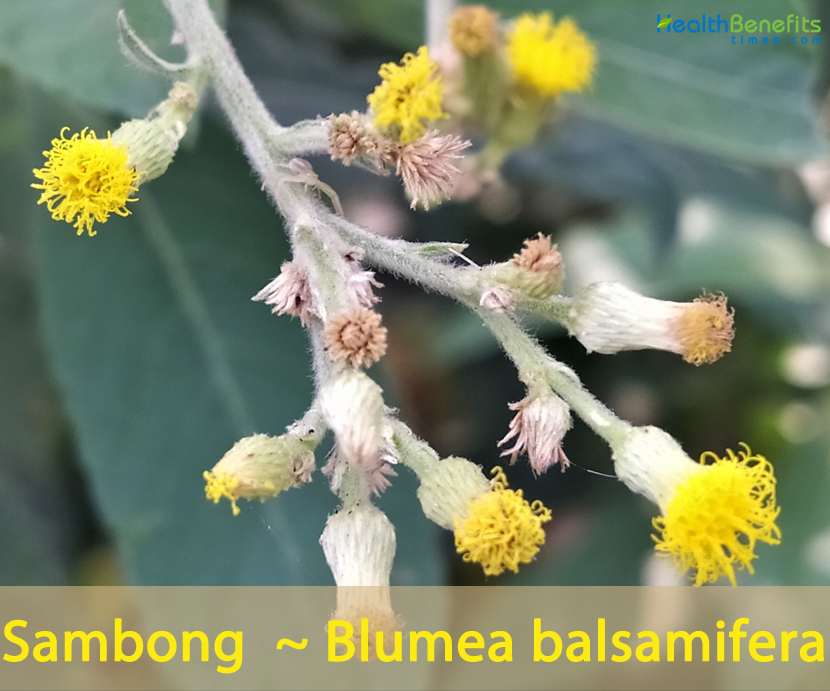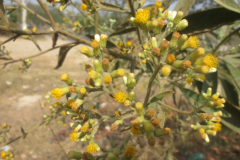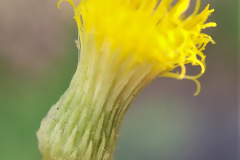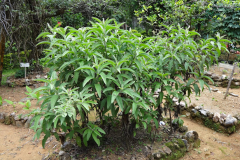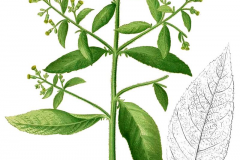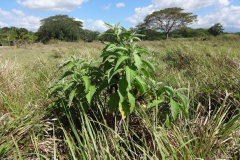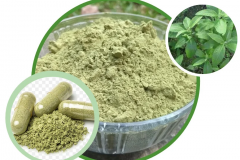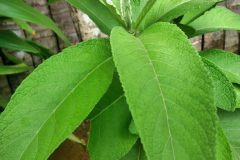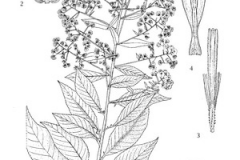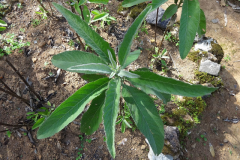The plant has a long history of medicinal use and is also the source of an essential oil. It is often harvested from the wild, whilst it is also grown in gardens and commercially. It is also often cultivated for both home use and on commercial scale, as it is commonly used as an herbal medicine. It have a very long traditions of use in medicinal systems of China, Vietnam, Thailand, India, Indonesia, The Philippines and other tropical and subtropical countries of that region. It have many health benefits and is famous for being good source of essential oil rich in borneol – compound that is similar but superior to camphor.
Sambong Facts
| Sambong Quick Facts | |
|---|---|
| Name: | Sambong |
| Scientific Name: | Blumea balsamifera |
| Origin | Andaman Is., Assam, Bangladesh, Borneo, Cambodia, Indo-China, southern China, Malaysia, Indonesia, Philippines Christmas I., Himalaya, India, Jawa, Laos, |
| Colors | Initially green turning to brown as they mature |
| Shapes | Minute, slightly curved, obscurely 5-ribbed achene |
| Taste | Pungent |
| Health benefits | Effective treatment for kidney stones, Treats Sore Throat, Cures Digestive Problems, Induces Urination, PMS relief, Prevents Cancer, Reduces edema, Cure fever, Helps Prevent Liver Disease, Lowers Blood Pressure, Treats Kidney Problem , Relieves Oral Pain, Prevents Diseases caused by Bacteria and Fungi, Rheumatism and Arthritis |
| Name | Sambong |
|---|---|
| Scientific Name | Blumea balsamifera |
| Native | Andaman Is., Assam, Bangladesh, Borneo, Cambodia, Indo-China, southern China, Malaysia, Indonesia, Philippines Christmas I., Himalaya, India, Jawa, Laos, Lesser Sunda Is., Malaya, Maluku, Burma (Myanmar), Nepal, New Guinea, Nicobar Is., Pakistan, Sri Lanka, Sulawesi, Sumatera, Taiwan, Thailand, Vietnam |
| Common Names | Ngai Camphor Plant, Nagi Camphor, Blumea Camphor, Camphor Plant, Buffalo-ear, Ngai camphor shrub, Ngai camphor tree |
| Name in Other Languages | Assamese: Kaphur goch, Mugongre Bengali: Kukur-soka, Kuk-sungh Bikol: Lakadbulan Burmese: Bhum m sein pain (ဘုမ္မသိန်ပင်), poung-ma-theing Cambodia: Bai mat Chinese: Ai Na Xiang (艾納香), Da Feng Ai, Pen tsao Dutch: Blumea-kamfer English: Buffalo-ear, Ngai camphor, Ngai camphorshrub, Ngai camphortree French: Camphrier, Sambong, camphre de bluméa German: Büffelohr Hindi: Kakoranda, kukronda, Buarthau, Langthrei Ilokano: Sobsob Indonesian: Sembung, capa, sembung utan, sembung gantung, Capa, Kuwuk, Mingsa, Langu, Kamadhin, Capo, Afoat, ampampau, Madikapu Javanese: Sembung Gatnung Kapampangan: Sambung Kannada: Kukuraadra Laos: Nat, phi ma ‘sen Malay: Pokok Sembung, Chapor, Chapa, Bonga Chapa Malaysia: Chapa, chapor, sembong Malayalam: Banga-chappa, sombong Marathi: Bhangaruda, Bhambuda, Bhamaruda Myanmar: Poung-ma-theing, Phone-ma-thien, Hpone-mathein Oriya: ପୋକଶୁଙ୍ଗା Paiwan: Karuveljevelj Philippines: Sambong, lakadbulan, subsub Portuguese: Conforeira-negai Sanskrit : Kukkura-dru, kukundara, tamracuda, Kukudru, Gangaapatri Sundanese: Sembung Utan Tagalog: Sambong Tamil: Cuvarru mullanki, kattu mullani, narak-karantai Thai: H̄nād (หนาด), kam phung, naat yai, naat Tibetan: Ku la Unani: Kakarondaa Urdu: Kakronda, kakronda buti, kakronda buti ka pani, kakronda buti sabz Vietnamese: Dại bi, cây dại bi, từ bi, cây từ bi, băng phiến, cây mai phiến Visayan: Alibon |
| Plant Growth Habit | Erect, half woody, evergreen, aromatic, undershrub or shrub, rarely a herb or small tree |
| Growing Climates | Along roadsides, dry fields, thickets, grasslands, mountain slopes, riverbanks, forest edges, valleys and grasses, in upland fields, fields infested with Imperata, and natural grazing lands, brushwood, forest, including bamboo and teak forests and sometimes in wet places on river banks |
| Plant Size | 1 to 4 meters high |
| Stem | Stem erect, 2-8 cm in diameter, simple at base, then repeatedly trifid; branches terete, densely woolly villous with yellow-white hairs |
| Bark | Bark greyish-brown, smooth; wood soft, white |
| Leaf | Leaves are simple, alternate, elliptic- to oblong-lanceolate, 7 to 20 centimeters long, toothed at the margins, pointed or blunt at the tip, narrowing to a short petiole which are often auricled or appendaged |
| Flowering season | October to November |
| Flower | Flowering heads are stalked, yellow and numerous, 6 to 7 millimeters long, and borne on branches of a terminal, spreading or pyramidal leafy panicle. Discoid flowers are of two types: peripheral ones tiny, more numerous, with tubular corolla; central flowers few, large with campanulate corolla |
| Fruit Shape & Size | Minute, slightly curved, obscurely 5-ribbed achene |
| Fruit Color | Initially green turning to brown as they mature |
| Flavor/Aroma | Smelling strongly of camphor |
| Taste | Pungent |
| Plant Parts Used | Leaves, roots |
| Propagation | By seed and by root and stem cuttings and layering |
| Season | March to April |
| Available Forms | Teas, dried leaves, powders, tablets, capsules, and many other forms |
| Health Benefits |
|
Plant Description
Sambong is an erect, half woody, evergreen, aromatic, undershrub or shrub, rarely an herb or small tree that smells strongly of camphor. The plant normally grows about 1 to 4 meters tall with branching stems 2 – 8cm in diameter that becomes woody, at least at the base. The plant is found growing along roadsides, dry fields, thickets, grasslands, mountain slopes, riverbanks, forest edges, valleys and grasses, in upland fields, fields infested with Imperata, and natural grazing lands, brushwood, forest, including bamboo and teak forests and sometimes in wet places on river banks. Stems are strong, erect and taupe, with longitudinal edges; upper internodes are covered by dense tawny non glandular hair. They are woody at the base and corymbosely attached and the bark is greyish-brown and smooth. The branches are cylindrical, densely lanate with yellowish white hairs.
Leaves
Leaves when triturated send out a unique, cool aroma, which can make people feel refreshed. The leaves at the bottom are wide ovoid or oblong-lanceolate in shape, 22–25 cm in length and 8–10 cm in width. Its base is attenuated with petiole, narrow linear appendants of 3–5 pairs on both sides, pubescenced above, slight brown or thick yellow-white silky-villous, highlighted below midrib, with lateral veins of 10–15 pairs. The leaves at the top are oblong-lanceolate or ovate-lanceolate in shape, 7–12 cm in length, 1.5–3.5 cm in width, with an acuminate apex, a slightly acuminate base, without petiole or with a short petiole with narrow linear appendants of 1–3 pairs, entire or with thin serration or pinnatopectinate. Capitulum is arranged in much more branched leafy panicles; a peduncle with yellow and dense pubescence; an involucre campanulate, and a dense pubescence at the back.
Flower
Inflorescence a head, 6-10 mm in diameter, the numerous heads arranged in a usually terminal, sometimes axillary panicle 10-50 cm long and 6-30 cm in diameter; peduncle 3-10 mm long; involucre campanulate; bracts in many rows, imbricate, linear-subulate, 1-9 mm long, inner ones longest, outer ones gradually shorter, densely woolly outside; receptacle 2-4 mm in diameter, slightly convex, alveolate, glabrous or with fimbriate margins of the pits, glabrescent.
Florets are heterogamous, numerous, tubular, hardly exserting from the involucre, yellow, marginal florets female, disk florets 8-28, bisexual; corolla of female florets are filiform, up to 6 mm long, 2-4-lobed, glabrous; corolla of bisexual florets are tubular, 5-7 mm long, 5-lobed, lobes triangular-ovate, acute, papillate, pubescent with colleters; stamens 5, anthers basally tailed, connective prolonged; style exserted, 2-branched at apex. Flowering normally takes place in between October to November.
Fruit
Fertile flowers are followed by minute, slightly curved, obscurely 5-ribbed achene. They are initially green turning to brown, oblong, terete, about 1mm and sparsely covered with soft hairs. The pappus is reddish and 4–6 mm in size.
Health benefits of Sambong
Phytochemical and pharmacological reviews have long studied the full potential of Sambong benefits; but what exactly are these benefits? Listed below are some of the common health benefits of using Sambong
1. Effective treatment for kidney stones
Research has concluded that Sambong extract helps to decrease the size of calcium oxalate crystals. Calcium oxalate is one of the most common types of stones found in our kidneys. Not only Sambong reduce the size of the crystals, but it also inhibited its aggregation. It means apart from being used as kidney stone treatment, Sambong helps in the prevention of stone formation.
2. Treats Sore Throat
Indeed, this kind of tea can help you to get rid of a sore throat. It acts as an expectorant by preventing mucus and phlegm. The greater things come from sambong tea is the way it relieves common cold and fever. So, if you suffer from a sore throat, then using sambong tea is a very good idea to try.
3. Cures Digestive Problems
Sambong tea is quite beneficial for curing digestive problems. It is related with the anti-diarrheal properties contained in it. In this case, it provides borneol, camphor, caryophyllene oxide, α-terpineol, β-caryophyllene, and terpineol that are beneficial to soothe your gastrointestinal tract. As a result, it can help to reduce the problems of digestion including diarrhea. Thus, if you suffer from digestive problems, then having a cup of sambong tea could really help you.
4. Induces Urination
As mentioned before, sambong tea acts as the diuretic which means it will help to induce urination. It will help your body to flush out sodium and excess fluid from the body through the urine. Indeed, as a result, it will prevent fluid retention. Then, if you want to have the great urination, then sambong tea is something that should be taken into account.
5. PMS relief
Sambong is a good antispasmodic agent that consists of volatile oils that sooth away diarrhea, cramping, and irritations. Sambong as a tea has also been used to sooth away menstrual cramps, help with bloating, and stimulate blood flow to the pelvic region. To make Sambong tea, you need to boil the Sambong leaves in water and let it simmer for about 10-15 minutes, prepare this tea and store it in a clean container. Drink this tea throughout the day, at least 3-4 times for maximum benefits. The smell is aromatic and pungent but soothing at the same time.
6. Prevents Cancer
As described previously, sambong tea has antibacterial properties and antioxidants. This means sambong tea can help to prevent the cancer risks. It has the anti-carcinogenic activity that can fight against hepatocellular carcinoma cells. Indeed, the methanolic effect contained in sambong tea can be the good choice for you to prevent certain health problems such as cancer.
7. Reduces edema
Edema, or commonly called “manas,” happens when our tissues or cavities retain fluids, resulting in swelling. The frequent urination caused by sambong helps to release those extra fluids, thus relieving the edema.
8. Cure fever
Drinking sambong tea helps to reduce fever. You can also boil the leaves and use the water in your bath. Sambong leaves can also do this trick.
9. Helps Prevent Liver Disease
Since sambong leaves help in detoxifying, it helps your liver to not overwork and protects it from various toxins that may cause liver damage. Medications like paracetamol may be dangerous to your liver, and drinking sambong tea may help reduce the risk of having server damages to your liver.
10. Lowers Blood Pressure
Drinking sambong tea in regular basis can help you to lower blood pressure. This is related with the benefit of this tea to act as a diuretic. Moreover, it also helps to remove excess sodium from the blood resulting in the low blood pressure. As a result, it also contributes to deal with hypertension as well.
11. Treats Kidney Problem
Sambong tea helps to treat kidney problem. It has been registered as a medicine in the Bureau of Foods and Drugs. In fact, The Department of Health in the Philippines said that sambong tea can help you to dissolve kidney stones. Moreover, it has shown that sambong can relieve kidney problems related to kidney transplant. Thus, if you have problems with kidney then having sambong tea can be a good idea.
12. Relieves Oral Pain
It’s been noticed that sambong tea serves as an analgesic for dental patients after a dental operation. Boil water with sambong leaves and make a tea out of it. When it’s warmer, you can gargle sambong tea. The pain should be now less if not entirely removed.
13. Prevents Diseases caused by Bacteria and Fungi
Sambong leaves consist of beta-carotene, cyptomeridiol, and lutein which are supposed to help fight bacterial and fungal infections. These can help prevent Bacillus subtilis, staphylococcus, and other harmful microbes from entering into your body.
14. Rheumatism and Arthritis
Boil sambong roots and leaves and make tea out of it and drink it if you’re suffering from arthritis attacks. You can also pound the roots and leaves and apply them topically as patches on the affected part of your rheumatism or arthritis attack. The oils in sambong will penetrate your skin and help reduce the symptoms of rheumatism.
Traditional uses and benefits of Sambong
- In China an essential oil obtained by steam distillation of young leaves of B. balsamifera, is widely used in medicine and in rituals.
- balsamifera have been used in Chinese medicine since ancient times as carminative, mild stimulant, vermifuge and as topical application for septic ulcers.
- Diuretic and kidney-stone medicine is prepared commercially from B. balsamifera in Philippines.
- Cigarettes containing the chopped, dried leaves are smoked to relieve the pain of sinusitis in Thailand.
- Decoction of fresh leaves, alone or in combination with other plant preparations are used as a bath for women after childbirth and also for young children.
- Decoction of the leaves is recommended against influenza, cough and dyspepsia in Vietnam.
- Poultices of pounded leaves are applied to treat hemorrhoids and an alcoholic maceration serves as a liniment for rheumatism.
- It is used to treat influenza, bronchitis, cough, arthritis, insomnia, dyspepsia and dysmenorrhea, either in infusion or as an inhalation over a steam bath.
- The plant is used as a topical application for septic ulcers.
- Leaves as poultice for abscesses.
- Decoction of roots and leaves are used for fevers, kidney stones, and cystitis.
- Sitz-bath of boiled leaves, 500 gm. to a gallon of water, for rheumatic pains of waist and back.
- It is used in upper and lower respiratory tract affections like sinusitis, asthmatic bronchitis, influenza.
- It is applied while hot over the sinuses.
- Fresh juice of leaves to wounds and cuts.
- Poultice of leaves are applied to the forehead for relief of headaches.
- In Dumingag, Zamboanga Del Sur, the Subanens use leaf infusion for the treatment of cough.
- It is used for postpartum baths.
- Leaves are used for the treatment of urolithiasis.
- For fever, leaves boiled and when lukewarm used as sponge bath.
- Decoction of roots is used for fever.
- Decoction of leaves, 50 gm. to a pint of boiling water, 4 glasses daily, for stomach pains.
- In SE Asia it is widely used for various women problems.
- Postpartum, leaves are used in hot fomentation over the uterus to induce rapid involution.
- It is also used for menorrhagia, dysmenorrhea, functional uterine bleeding and leucorrhea.
- Roots are used for menorrhagia.
- It is also used for treatment of postpartum joint pains.
- Poultice of fresh leaves are applied to affected joint.
- In Chinese and Thai medicine, leaves are used for treatment of septic wounds and other infections.
- A sitz-bath of boiled leaves is used in the treatment of lumbago and sciatica.
- In Mizoram, India, decoction or infusion of leaves and bark are taken orally as expectorant.
- Dayak people in Central Kalimantan use the plant for antifertility effect.
- In northeast India, the Maring tribe of Manipur drinks a paste of crushed leaves mixed in water for burning sensation of the stomach.
- The whole plant or its leaves were used as a crude Chinese traditional medicinal material to treat eczema, dermatitis, beriberi, lumbago, menorrhagia, rheumatism, skin injury, and as an insecticide.
- Sambong is an herb used to treat urolithiasis (urinary tract or kidney stones) and urinary tract infections, and thus reduces high blood pressure.
- It is advised for persons with edema (manas), high blood pressure and kidney troubles.
- Decoctions of Blumea leaves are used for the same ailments as lotion or for wraps.
- Alcoholic macerations are also made for use as liniment for rheumatism.
- In Indo-China smoke from burning leaves of B. balsamifera is believed to be ideal for restoring normal breathing functions.
- In the Philippines leaves are burnt on hot coal to generate smoke for inhaling to relief asthma, for this purpose it is sometimes combined with Euphorbia hirta.
- In India fresh juice is squeezed from the leaves and dropped into the eyes in chronic purulent discharge.
- In Myanmar juice squeezed from the leaves is used as an eye-drop during malaria, and drunk in doses 20-60 ml.
- In Bengal powdered leaves are snuffed and eaten with butter for nose disease called ”Ahwah”, which causes strong fever and back pains.
- Fresh pounded leaves mixed with coconut oil are rubbed over the abdomen of children with gas pain.
- It can be taken as an early afternoon tea to maintain a healthy urinary tract.
Ayurvedic Health benefits of Sambong
- Fever: Decoction of roots; boil 2 – 4 handfuls of the leaves. Use the lukewarm decoction as a sponge bath.
- Headaches: apply pounded leaves on the forehead and temples. Hold in place with a clean piece of cloth.
- Gas distention: boil 2 tsp of the chopped leaves in 1 cup of water for 5 minutes. Drink the decoction while warm. Also used for upset stomach.
- Boils: Apply pounded leaves as poultice daily.
- Diuretic: Boil 2 tbsp. chopped leaves in 2 glasses of water for 15 minutes. Take 1/2 of the decoction after every meal, 3 times a day.
- Fever: Roots and leaves are pounded then dissolved in cold water. Applied with a soft cloth over the nape, forehead, underarms, and other body parts to bring down the body temperature.
- Rheumatism: Roots and leaves are pounded and applied as poultice on the affected body parts. It may also be boiled and applied as a warm compress onto the affected area.
- Headaches: Leaves are pounded and applied as a poultice over the forehead.
Culinary Uses
- Camphor-scented leaves are occasionally used as an aromatic condiment with various foods.
- Leaves are used a flavoring ingredient.
- In Indonesia, the Balinese people use it as a traditional drink called “Loloh Sembung”, made by boiling and brewing fresh and dried leaves.
- The Bodos of Assam, India, use it as a flavoring herb, added to soups, curries, or as a side dish with chilies and native soda ash water called “kharwi.”
- In the Philippines infusions from dried or chopped fresh leaves of Blumea Balsamifera are drunk as a tea substitute.
- The leaves are also used fresh to make pungent chutney – Shaphinyaba in Assam.
- Both dried and fresh as a bitter aromatic spice, in the same way as Sage or Artemisias.
Usual dose for Sambong
Sambong benefits can be harnessed in various ways. A gentle reminder: the dosages and applications listed below are meant to help and should not be prioritized over a physician’s advice.
Tablets
Commercially prepared medication, especially in tablet form, must always be taken according to the doctor’s advice. However, there are usual doses. If used as a diuretic agent, one should take 2 tablets 3 times a day.
One tablet typically consists of 250 mg of powdered sambong leaves. If it will be used to combat kidney stones, the ideal dose is 40-50 mg per kilogram of body weight per day. Divide the total into three equal doses.
Tea or Decoction
If you will consume sambong as a tea or decoction, boil the leaves and drink one glass 3 to 4 times daily. The same decoction can also be used in a sponge bath if you want to relieve fever. Additionally, you can drink the tea made from boiling sambong roots to decrease body temperature.
Poultice
For pains, like headache, crush the leaves and press them onto the affected area.
Other Facts
- In gardens, leaves are picked when required.
- On a larger scale, leaves are cut up to four times a year or whole plants are harvested.
- Leaf has very pleasant aromatic smell.
- It is used in food to give pleasant smell.
- In China ngai camphor oil, an essential oil obtained by steam distillation of the young leaves, is widely used in medicine and in rituals.
- Roots and leaves are used as natural pesticides e.g. against storage pests and leaf hoppers in rice.
- Roots and leaves used as natural pesticides against storage pests and leaf hoppers in rice.
- Dry or fresh leaves and stems are burned or hung inside the house.
- In Thai folklore, it is reputed to ward off spirits.
Precautions
- Not enough is known about the use of sambong during pregnancy and breastfeeding. Stay on the safe side and avoid use.
- Sambong can cause allergic reactions for people sensitive to ragweed plants and their relatives. Side effects may include itching and skin irritation.
References:
https://www.itis.gov/servlet/SingleRpt/SingleRpt?search_topic=TSN&search_value=505923#null
https://gd.eppo.int/taxon/BLUBA
http://www.theplantlist.org/tpl1.1/record/gcc-102702
https://uses.plantnet-project.org/en/Blumea_balsamifera_(PROSEA)
https://indiabiodiversity.org/species/show/259915#folklore
http://www.stuartxchange.com/Sambong.html
https://en.wikipedia.org/wiki/Blumea_balsamifera
https://spain.inaturalist.org/taxa/347625-Blumea-balsamifera
https://ayurwiki.org/Ayurwiki/Blumea_balsamifera_-_Kukundara
https://tropical.theferns.info/viewtropical.php?id=Blumea+balsamifera
https://plants.usda.gov/home/plantProfile?symbol=BLBA2


